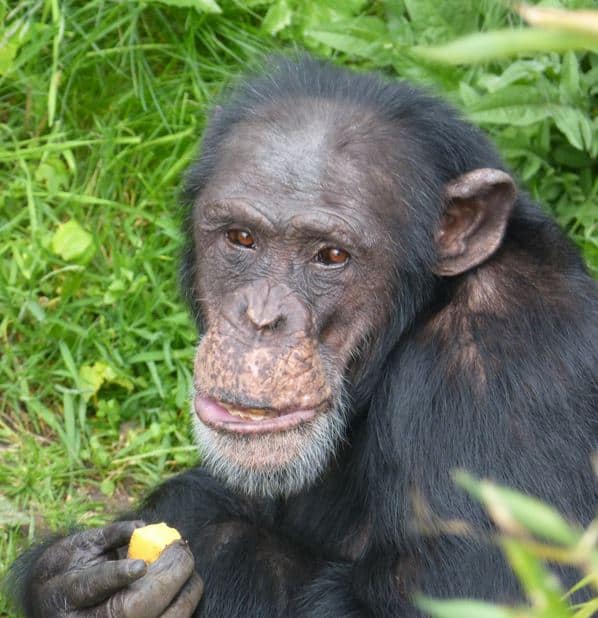Dutch and Scottish chimps have a different sounding grunt for “apple”, but when the Dutch animals moved in with the Scottish ones, they eventually adopted the local grunt. This occurred when a strong friendship had been established.
The chimpanzees at Beekse Bergen Safari Park in the Netherlands had a high-pitched grunt for “apple”, while at Edinburgh Zoo their word for the same fruit was uttered at a much lower pitch.
When some Dutch chimps were moved into Edinburgh Zoo, they adopted the Scottish word for the fruit after three years.
Researchers from the University of York in England and the University of Zurich in Switzerland explained that when the two chimp communities collided, their utterances converged.
This is the first study with clear evidence that chimps “learn” calls that refer to specific things. The researchers’ findings have been published in Current Biology.

Frek, who came from Beekse Bergen group but now lives in Edinburgh. At the bottom of this page, listen to how his grunt-word for “apple” changed from 2010 to 2013. (Photo credit: Jamie Norris. Image: York University)
Chimps have a vocabulary with specific “words”
When they find certain types of foods, chimps utter distinct sounds in the form of grunts. Their companions understand what the different-sounding grunts mean.
Chimp researchers have always assumed that non-human primates had virtually no control over the structure of their calls. It was thought that their utterance’s structure was a read-out to arousal, i.e. sounds were made out of general excitement or preference for food.
The research team had a unique opportunity to see whether, and if so how, chimpanzees could alter the structure of their food calls when some of the animals from the Dutch community were permanently moved to Edinburgh Zoo in 2010, thus joining the Scottish group.
Before being transferred, the team noted that the animals in each group had a different grunt-sound for “apples” – they spoke different languages. They also noticed that their preferences for apples were different.
Adopting new language took three years
Three years after being transferred, the Dutch chimps’ vocabulary had changed – they had adopted the Scottish grunt-sound for apple.
Animal experts have always explained that chimps, gorillas and other non-human primates can utter sounds, such as alarm or food calls, that refer to external objects in the environment. They have also said that these animals’ acoustic structure is not flexible, it is fixed and is a product of arousal state.
Many biologists, zoologists and animal psychologists insist that chimps’ seeming lack of flexible control of their grunt sounds shows that they do not possess “language”.
In this latest study, Dr. Katie Slocombe, who works in the Department of Psychology at the University of York, and team, believe this long-standing assumption is wrong. They insist that captive chimpanzees have “learned” grunts that have distinct meanings.
The animals can also eventually adapt the structure of their meaningful grunts to the sounds of a new community – they are also able to adopt new accents or vocabularies.
The Dutch chimps’ grunts were recorded in 2010 before they were transferred, then again in 2011 after their transfer, and finally in 2013.
New accents are adopted after the new chimps bond
The researchers noted that twelve months after being transferred to Edinburgh, the Dutch chimps’ “accent” or “grunt-word” for apple had not changed – they were still speaking in the Dutch way.
It wasn’t until 2013, when social network analyses suggested that the Dutch chimps had established strong friendships with the Scottish animals, that the call structures converged.
Dr. Slocombe explained:
“An extraordinary feature of human language is our ability to reference external objects and events with socially learned symbols, or words. These data represent the first evidence of non-human animals actively modifying and socially learning the structure of a meaningful referential vocalization.”
“Our findings indicate that primate referential call structure is not simply determined by arousal, and that the socially learnt nature of referential words in humans is likely to have ancient evolutionary origins.”
Dr. Simon Townsend, who works at the University of Zurich, said:
“These findings might shed some light on the evolutionary origins of these abilities. The fact that both humans and now chimpanzees possess this basic ability suggests that our shared common ancestor living over 6 million years ago may also have been socially learning referential vocalizations.”
Reference: Stuart K. Watson, Simon W. Townsend, Anne M. Schel, Claudia Wilke, Emma K. Wallace, Leveda Cheng, Victoria West, Katie E. Slocombe. “Vocal Learning in the Functionally Referential Food Grunts of Chimpanzees.” Current Biology. DOI: http://dx.doi.org/10.1016/j.cub.2014.12.032.
Listen to how Frek’s accent changed in 3 years
2010: Frek (a Dutch chimp), he had a very high pitched grunt for “apple”.
2010: Lucy (an Edinburgh chimp), her grunt for “apple” has a much lower pitch.
2013: Frek’s grunt now sounds much more like Lucy’s. He has picked up the Scottish accent.
